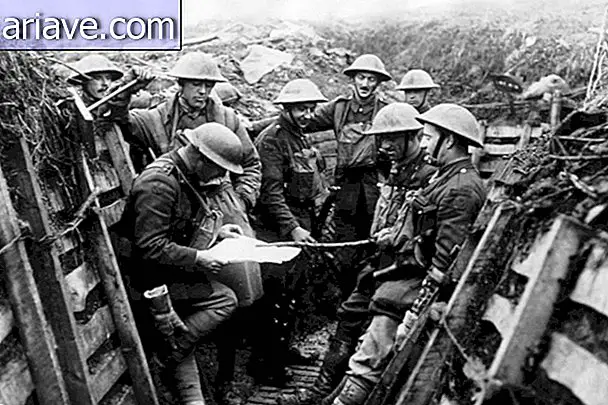88 years of World Cup tickets
In World Cup periods, concerns are usually limited to who will head each group, who will reach the octaves, Wednesdays and semifinals, and finally who will lift the cup and provoke a nation's general whimper - and it is expected to be Brazil, of course. However, after the euphoria, the memories, photos and a very common souvenir will be left: the tickets of the matches.
Well, what can you say? Thankfully, this "collector" craze isn't nearly recent. Thus, it is possible to see how this item of essential importance for the fan - although somewhat underappreciated in its own time - has changed and shown trends over decades of Worlds.
It goes from the relatively acetic style of tickets to the first World Cup in 1930 to the logos added in the 1970s and then to the ever more elaborate graphics - culminating in the feast of colors and lines seen in the glorious 1994 edition., where we won the four-time championship. In fact, it is over 80 years of a discreet but constant recorded history. Check out the selection made by the Creative Bloq site.
1930 - Uruguay vs. Argentina (final)

With simple typography and functional design, tickets from the first Uruguay-based World Cup could be worth a small fortune currently at auctions.
1934 - Spain v. Brazil (group stage)

Somewhat more elaborate than the tickets used at the previous event, the first World Cup held in Italy made use of the bold three-dimensional solution as a source, highlighting the venue. In addition, blue and white mosaics and layouts complement the art of the ticket - which can still be seen despite the age of the print.
1938 - France vs. Belgium (group stage)

Style with minimalist strokes in a beautiful combination of fonts - plus a somewhat unusual green stripe.
1950 - England v. Spain (group stage)

After a break of 12 years due to the notorious global upheavals of the time (World War II), this is the first edition held in Tupiniquim territory. At the time, the ticket resumes part of the style originally used in 1938, in a scheme based on three colors. It is also the first ticket to include a southpaw.
1954 - West Germany vs. Hungary (final)

In the 50th anniversary of FIFA, the Swiss World Cup ticket returns to a more traditional design, though with some random (and left-handed) graphics.
1958 - Sweden (various)

The FIFA World Cup edition in Sweden appears with far less subtle tickets than the previous ones. A distinctive typography and colorful horizontal stripes complement the top right emblem.
1962 - Brazil v. Czechoslovakia (final)

Yes, it is true, the tickets to the 1962 Chile-based World Cup looked a lot like collectible stickers. Note that the above copy still has a beautiful differential: an autograph from Pelé.
1966 - England v. West Germany (final)

Tickets for the 1966 World Cup in England, though not so prominent in design, were a welcome feature: tickets showed exactly where you should sit inside the stadium.
1970 - Brazil vs. England (quarterfinals)

The edition of the Brazilian third championship is also the first use of a logo associated with the event - as opposed to the departure time, displayed in an analogous way.
1974 - Australia v. Chile (group stage)

The 1974 tickets also earn points for functionality. In addition to the analogously displayed departure time, there is also the seat number and an image that leaves no doubt about your seat at the stadium.
1978 - Netherlands v. Argentina (final)

In 1978 FIFA used a style that would echo in subsequent editions of the event. This is the electronic scoreboard style score. In addition, there is also the time shown in analog form (with digital, in 24-hour format immediately above) and the date of departure.
1982 - Germany v. France (semifinal)

The 1982 World Cup, based in Spain, brought tickets whose colors mentioned the colors of the country. This is also the first appearance of a digital display of the departure time and also the ticket price.
1986 - Soviet Union vs. Canada (group stage)

Upon returning to Mexico, the World Cup wins tickets that are a mix of the 1970s style (also based in that country), while maintaining the traditional score used in 1978.
1990 - West Germany vs. Argentina (final)

Based in Italy, the 1990 World Cup admitted entry to the stadiums through a ticket whose colors, purposely worn, made reference to the country's flag. Interestingly, the ticket design rescues the three-dimensional font previously used only on 1934 tickets.
1994 - Brazil vs. Italy (final)

Lots of colors to mark the entrance to the historic match that ensured the Brazilian National Team won the four-time championship - in addition to scoring one of the most famous penalty kicks in FIFA Cups, to Italy's dismay. In addition, there was a very pronounced logo highlighting the hosts, the United States of America (World Cup USA) - yet another profusion of different details and fonts for the lyrics.
1998 - France vs. Brazil (Final)

Here is the ticket to the fateful final between Brazil and France during the 1998 World Cup. Blue and white color schemes were still gaining a flashy reddish globe (somewhat weathered there, it is true). With text marked by dot matrix printer, it is still the first post-1970 ticket not to bring a logo of the event.
2002 - Brazil vs. Germany (final)

Here is a particularly pioneering issue. After all, it was the first time two countries hosted a World Cup (Japan and South Korea), and it was also the first time the event was held in venues outside the Americas and Europe. As for tickets, what happened there was a rescue of the particularly colorful style used at the 1994 United States Cup.
2006 - Italy vs. France (final)

Whoever bought one of these got to see firsthand Italy's conquest of the fourth championship ... And also the famous Zinedine Zidane header. As for design, you can see the same unique font used for lettering on the logo and on stadium and team names. Each ticket contained a number, which, in fact, was the only information contained in the ticket stub.
2010 - Spain vs. Netherlands (final)

Combined with elements from the 2002 and 2006 World Cup editions, tickets for the nineteenth edition of the event, held in South Africa, also made use of some design solutions used in the 1994 ticket. Again, look at the custom font. to the letters. There is also the choice for a vertical print and a beautiful complement of the colors gold, red, green and purple.
2014 - Brazil (various)
These are some of the tickets that guaranteed tears, tension, joy and some trauma (we will never forget the 7 to 1!) During the edition of the FIFA World Cup here in Brazil, the second held in Tupiniquim territory. In addition to the multicolored - albeit somewhat controversial - Fuleco, there was no shortage of information and color choices that tremendously distanced the souvenir from the stark prints of the first half of the last century.
2018 - Russia

We finally got to the 2018 World Cup tickets, which start today - with the opening match between the home owners and Saudi Arabia. Although the party atmosphere is still a little cold when compared to previous editions of the World Cup, but Brazilians love football and it is impossible to resist and not join the crowd. And come the hex, right?
Now wait to see what kind of excitement will be associated with these little papers in the near future.
* Originally posted on 24/06/2014 and updated on 14/06/2018.
***
Do you know the Mega Curioso newsletter? Weekly, we produce exclusive content for lovers of the biggest curiosities and bizarres of this big world! Register your email and do not miss this way to keep in touch!












